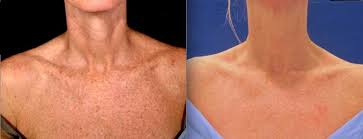Fraxel for neck and chest rejuvenation offers a game-changing solution for those seeking youthful skin. Traditional treatments, unlike laser skin rejuvenation and fractional skin resurfacing, can be invasive and require long recovery times. In contrast, Fraxel is non-invasive and allows for minimal downtime, making it a popular choice. This innovative laser treatment targets signs of aging, sun damage, and uneven texture effectively.
Many patients experience noticeable improvements in their skin’s appearance after just a few sessions. The results of laser skin resurfacing are natural-looking, enhancing your confidence without drastic changes. If you’re tired of dull, aged skin on your neck and chest, Fraxel could be the answer. Discover how this advanced technology can rejuvenate your skin while fitting seamlessly into your busy life.
Key Takeaways
-
Fraxel laser therapy is an effective option for rejuvenating the neck and chest, addressing issues like wrinkles and sun damage.
-
Before the procedure, consult with a qualified practitioner to discuss your skin concerns and set realistic expectations for results.
-
Prepare for your treatment by avoiding sun exposure and certain medications that can increase sensitivity.
-
During the procedure, expect a sensation similar to a rubber band snap; managing discomfort can be achieved with topical numbing creams or cooling devices.
-
Follow essential aftercare tips, such as moisturizing and protecting your skin from the sun, to enhance healing and results.
-
Recovery times vary, but most people can return to normal activities within a week; patience is key for optimal results.
Understanding Fraxel Laser Therapy
Technology Overview
Fraxel laser therapy uses fractionated laser technology to rejuvenate the skin. This method involves delivering thousands of tiny beams of light to the skin. These beams penetrate deep into the skin layers. They create microscopic wounds while leaving surrounding tissue intact. This process promotes faster healing and stimulates collagen production. As a result, patients experience smoother and firmer skin.
Wavelength Differences
The two main wavelengths used in Fraxel treatments are 1550nm and 1927nm. The 1550nm wavelength is effective for deeper skin issues. It treats conditions like wrinkles and scars by targeting the dermis layer. The 1927nm wavelength focuses on superficial skin problems. It addresses issues like pigmentation and sun damage. Different laser treatments cater to specific needs, allowing customized treatment plans.
Skin Issues Addressed
Fraxel laser therapy can address various skin concerns. It effectively treats sun damage, which includes dark spots and uneven texture. Many patients seek Fraxel for its ability to reduce fine lines and wrinkles. It can also improve acne scars and other types of scarring. Patients often notice a significant improvement in their skin’s appearance after treatment.
Treatment Options
Many laser treatment options exist within cosmetic laser dermatology. Fraxel stands out due to its advanced technology and effectiveness. Other treatments include conventional laser skin resurfacing, which may require more downtime. In contrast, Fraxel offers a unique approach with minimal recovery time. Patients can typically return to their daily activities quickly.
Benefits of Fraxel
Patients enjoy several benefits from choosing Fraxel therapy. The procedure is less invasive than traditional methods. There’s reduced risk of complications, making it a safer option for many individuals. Results appear gradually, leading to a more natural look over time. This gradual improvement contributes to the youthful look many desire.
Safety and Considerations
Safety remains a priority in any laser treatment option. Fraxel has been proven safe for various skin types and tones. However, it’s essential to consult with a qualified dermatologist before proceeding. They can assess individual needs and determine if this treatment is suitable.
Benefits for Neck and Chest
Skin Texture
Fraxel laser therapy significantly improves skin texture on the neck and chest. It works by creating tiny wounds in the skin. This process triggers the body’s natural healing response. As a result, new skin cells form, leading to smoother skin.
The treatment reduces the appearance of wrinkles. Patients notice fewer fine lines after their sessions. The laser targets damaged skin without harming surrounding areas. This precision helps rejuvenate the skin effectively.
Skin Tone
Fraxel also enhances skin tone and radiance. The treatment stimulates collagen production. Collagen is essential for maintaining skin elasticity and firmness. Improved collagen levels lead to a more even skin tone.
Patients often report a brighter complexion after treatment. Dark spots and discoloration diminish over time. This change occurs as the laser promotes cell turnover. The result is healthier-looking skin that reflects light better.
Non-Invasive Treatment
Fraxel offers a non-invasive solution for rejuvenation. Unlike surgical options, it requires no cuts or stitches. Most patients find the procedure comfortable with minimal discomfort.
Sessions typically last about 30 minutes to an hour, depending on the area treated. Patients can return to normal activities shortly after treatment. Some redness may occur, similar to a mild sunburn, but it fades quickly.
Minimal Downtime
Minimal downtime is one of Fraxel’s major advantages. Many people appreciate this aspect of the treatment. They can easily fit it into their busy schedules without long recovery times.
Most individuals resume daily activities within a day or two. This convenience makes Fraxel a popular choice among those seeking full skin rejuvenation for their neck and chest.
Alternatives to Collagen
For those looking for alternatives, Fraxel stands out among various treatments available today. Other options often include topical creams or injections that provide short-term results.
However, these alternatives do not offer the same long-lasting effects as Fraxel therapy. The laser treatment addresses deeper layers of skin effectively, promoting lasting improvement in texture and tone.
Patients seeking options for chest wrinkle laser treatment find Fraxel particularly effective. It combines safety with powerful results, making it suitable for many individuals.
Preparing for the Procedure
Consultation Importance
Consulting a dermatologist is crucial before undergoing Fraxel treatments. A professional can assess your skin type and condition. They will determine if cosmetic laser surgery is suitable for you. This step ensures safety and effectiveness. Discuss any previous skin issues or treatments with the doctor. Sharing this information helps tailor the procedure to your needs.
Avoiding Sun Exposure
Avoid sun exposure before the treatment. Direct sunlight can make your skin more sensitive. It increases the risk of complications during the procedure. Dermatologists often recommend staying out of the sun for at least two weeks prior. Use sunscreen with high SPF if sun exposure cannot be avoided. This protects your skin and prepares it for skin resurfacing.
Medication Considerations
Certain medications may interfere with the treatment process. Discuss all medications you are taking with your dermatologist. Blood thinners, for example, can increase bleeding risks during cosmetic procedures. Your doctor may recommend pausing these medications temporarily. Always follow their advice to ensure a smooth recovery.
Skin Condition History
Discuss any history of skin conditions with your practitioner. Conditions like eczema or psoriasis can affect treatment outcomes. Informing your dermatologist allows them to adjust their approach as needed. They may suggest alternative treatments if necessary.
Understanding Downtime
Understand that there will be some downtime after the procedure. Recovery time varies from person to person. Some may experience redness or swelling, similar to a sunburn. Most people return to normal activities within a few days, but it’s wise to plan accordingly. Your dermatologist will provide specific guidelines on post-treatment care.
Post-Treatment Care
Follow post-treatment care instructions closely. Proper care aids in healing and enhances results. Avoid harsh skincare products immediately after the procedure. Stick to gentle cleansers and moisturizers recommended by your dermatologist.
Results Timeline
Results from Fraxel treatments typically appear gradually over several weeks. Initial improvements may be visible soon after, but optimal results take time. Skin continues to improve as collagen production increases over months.
Long-Term Maintenance
Consider long-term maintenance options after initial treatments. Regular touch-ups can help maintain youthful skin appearance on the neck and chest areas. Discuss these options with your dermatologist during follow-up visits.
What to Expect During Treatment
Session Duration
A typical Fraxel session lasts between 30 to 60 minutes. The exact time depends on the area being treated. For neck and chest rejuvenation, sessions may take longer due to the larger surface area. Patients can expect a quick procedure that fits into their busy schedules..

Sensations Experienced
During the laser treatment, patients often feel sensations of warmth or tingling. This feeling occurs as the laser penetrates the skin layers. Some describe it as similar to a mild sunburn. Most find this sensation manageable. Everyone’s pain tolerance varies, so experiences can differ.
Topical Anesthetics
To minimize discomfort, practitioners apply topical anesthetics before starting the treatment. These creams numb the skin effectively. They help reduce any pain or discomfort during the procedure. Patients usually wait about 20 to 30 minutes for the anesthetic to take effect. This preparation enhances comfort levels throughout the session.
Post-Treatment Care
After the cosmetic treatment, patients may notice redness or swelling in the treated areas. These symptoms typically resolve within a few days. It’s important to follow aftercare instructions provided by the practitioner for optimal results. Staying hydrated and using gentle skincare products aids recovery.
Follow-Up Sessions
Most individuals require multiple Fraxel sessions for best results. Treatments are usually spaced about four to six weeks apart. This schedule allows the skin to heal properly between sessions. Practitioners will assess progress and suggest adjustments as needed.
Results Timeline
Visible improvements begin to appear about one week post-treatment. Skin texture and tone gradually enhance over several months. Patients should maintain realistic expectations regarding their cosmetic outcomes. Full results become evident after completing all recommended sessions.
Overall Experience
Patients often report satisfaction with their skin resurfacing treatment experience. The combination of effective techniques and advanced technology makes Fraxel popular among those seeking rejuvenation. Many appreciate how quickly they can return to daily activities after treatment.
Managing Discomfort Effectively
Soothe with Compresses
After undergoing Fraxel treatment, discomfort may occur. Applying cool compresses can help soothe the treated areas. This method reduces swelling and eases pain. Use a clean cloth soaked in cool water. Place it gently on the skin for about 10 to 15 minutes. Repeat this process several times a day as needed.
Keeping the skin cool aids in recovery. It also minimizes redness and irritation. Patients often find this simple step very effective.
Pain Relief Options
Over-the-counter pain relief options are available if discomfort persists. Non-prescription medications like ibuprofen or acetaminophen can provide relief. These products help reduce inflammation and alleviate pain. Always follow the recommended dosage on the packaging.
Consulting with your healthcare provider is wise if pain continues. They might suggest stronger medications or alternative treatments based on individual needs.
Follow Skincare Advice
Following your practitioner’s advice is crucial for post-treatment care. They will recommend specific skincare products to use after Fraxel treatment. Adhering to these guidelines promotes healing and ensures optimal results.
Gentle cleansers and moisturizers are often suggested. Avoid harsh chemicals or exfoliants during the healing phase. Your skin will be sensitive, so it’s important to keep it hydrated and protected.
In some cases, practitioners may recommend specific products that contain soothing ingredients like aloe vera or hyaluronic acid. These ingredients can enhance skin recovery and comfort.
Monitor Skin Changes
Monitoring any changes in your skin is essential after treatment. Look for signs of excessive redness, swelling, or unusual discomfort. If any of these symptoms occur, contact your practitioner immediately.
Regular check-ins with your healthcare provider ensure that healing progresses smoothly. They can provide additional support or adjustments to your care plan if necessary.
Time for Recovery
Recovery time varies from person to person. Most patients notice improvements within a few days to weeks following treatment. However, complete healing may take longer depending on individual skin types and conditions.
Patience is key during this period. Allow the skin time to recover properly for the best results from Fraxel treatment.
Essential Aftercare Tips
Sunscreen Use
Using sunscreen is crucial after undergoing Fraxel treatment. The skin remains sensitive for several weeks post-procedure. Protecting the treated area from UV rays helps prevent complications like hyperpigmentation.
Choose a broad-spectrum sunscreen with an SPF of 30 or higher. Apply it daily, even on cloudy days. Reapply every two hours if you are outdoors. This simple step can make a significant difference in your skin’s recovery.
Gentle Cleansing
Gentle cleansing routines are essential to avoid irritation. Harsh cleansers can strip the skin of its natural oils and disrupt the healing process. Opt for a mild, fragrance-free cleanser. This will help maintain the skin’s barrier while keeping it clean.
Wash your neck and chest with lukewarm water. Hot water can increase sensitivity and redness. Pat your skin dry with a soft towel instead of rubbing it. This minimizes friction and reduces irritation.
Moisturizing
Moisturizing plays a key role in supporting skin healing after Fraxel treatment. Well-hydrated skin heals faster and looks better. Use a gentle, hydrating moisturizer that suits your skin type.
Apply moisturizer twice daily to keep the skin supple. Look for products containing ingredients like hyaluronic acid or glycerin, which attract moisture to the skin. These ingredients help in restoring hydration levels effectively.
Avoiding Irritants
Avoid irritants during the healing phase. Stay away from products with alcohol, retinoids, or strong exfoliants for at least two weeks post-treatment. These can cause unnecessary irritation and delay recovery.
Listen to your skin. If a product causes discomfort, stop using it immediately. Always patch-test new products before applying them to larger areas.
Hydration
Staying hydrated is vital for overall skin health. Drink plenty of water throughout the day. Proper hydration helps support cellular function and promotes healing from within.
Consider adding foods rich in antioxidants to your diet as well. Fruits and vegetables contribute to better skin health and aid in recovery after treatments like Fraxel.
Follow-Up Appointments
Schedule follow-up appointments with your dermatologist as advised. Regular check-ins allow professionals to monitor your healing progress and address any concerns you may have.
These appointments provide an opportunity to discuss any issues or side effects you experience during recovery. They can recommend adjustments to your skincare routine if needed.
Recovery Timeline Overview
Initial Phase
The first phase of recovery typically occurs within the first week after treatment. Patients often experience redness and mild swelling. This reaction is a normal part of the healing process as the skin begins to respond to the fractional laser treatment.
Peeling may start around day three or four. It’s essential to avoid picking at the peeling skin. Doing so can lead to scarring or infections. The initial redness usually fades significantly by the end of the first week.
Visible Improvements
After the initial phase, visible improvements begin to appear. Most patients notice changes in their skin texture and tone within two weeks. The skin may look smoother and more even.
By weeks three to four, results become more pronounced. Fine lines and wrinkles diminish as new collagen forms under the skin. Many individuals report feeling more confident during this time due to improved appearance.
Long-term Changes
Long-term changes continue for several months post-treatment. Around three to six months after the procedure, patients can see full results. The skin appears firmer and rejuvenated as it undergoes fractional wound healing results.
Collagen production peaks during this period, enhancing overall skin quality. Regular follow-up sessions may further improve outcomes and prolong effects.
Factors Influencing Recovery
Several factors can influence individual recovery times after Fraxel treatment. Skin type plays a crucial role in how quickly one heals. For instance, people with sensitive skin may experience longer recovery periods.
Age is another factor; younger individuals often heal faster than older ones. Overall health also affects recovery speed. Those with underlying health issues might take longer to see results.
Adherence to aftercare instructions is vital as well. Proper skincare routines aid in quicker healing and better results. Sun exposure should be minimized during recovery, as it can cause complications.
Finding a Qualified Practitioner
Credentials Check
Researching practitioners’ credentials is crucial. Look for board certification in dermatology or plastic surgery. This ensures they have the necessary training and expertise. Experience with Fraxel treatments specifically is also important. Ask how many procedures they have performed. A practitioner with a strong background in laser treatments can provide better results.
Patient Reviews
Reading patient reviews offers valuable insights. Online platforms like RealSelf or Healthgrades provide feedback from real patients. Look for comments about the practitioner’s skill, bedside manner, and overall satisfaction. Positive testimonials can indicate a reliable provider. Pay attention to any recurring concerns mentioned by patients. This can help you make an informed decision.
Schedule Consultations
Scheduling consultations is an essential step. Meet with potential practitioners to discuss your goals. Bring up your concerns regarding neck and chest rejuvenation. A qualified practitioner will listen and address your questions thoroughly. They should explain the procedure, expected outcomes, and any risks involved.
During these meetings, observe their communication style. A good practitioner will make you feel comfortable and valued. They should be transparent about what to expect before, during, and after treatment.
Treatment Plans
Discuss personalized treatment plans during consultations. Each patient’s skin type and condition are unique. Practitioners should tailor their approach based on individual needs. Ask how they plan to achieve your desired results. This can include the number of sessions required and any additional treatments that may complement Fraxel.
Cost Considerations
Inquire about costs associated with the procedure. Understand what is included in the price. Some practitioners offer financing options, which can ease financial burdens. Ensure you know about any hidden fees as well.
Follow-Up Care
Follow-up care is another critical topic to address. Ask about post-treatment care recommendations. Proper aftercare can significantly affect recovery and results. A responsible practitioner will outline these steps clearly.
Trust Your Instincts
Trust your instincts when selecting a practitioner. If something feels off during consultations, consider other options. Finding someone who makes you feel confident in their abilities is vital.
Fraxel treatments can yield excellent results for neck and chest rejuvenation when performed by a qualified professional. Taking time to research credentials, read reviews, and schedule consultations pays off in the long run.
Closing Thoughts
Fraxel laser therapy offers a powerful solution for rejuvenating your neck and chest. With benefits like improved skin texture, reduced wrinkles, and enhanced tone, it can transform how you feel about your appearance. Proper preparation, effective pain management, and attentive aftercare are crucial for achieving the best results.
Finding a qualified practitioner is key to a successful experience. Trust their expertise to guide you through the process. If you’re ready to reclaim your youthful glow, consider scheduling a consultation today. Your skin deserves the best care!
Frequently Asked Questions
What is Fraxel laser therapy?
Fraxel laser therapy is a non-invasive treatment that uses fractional laser technology to rejuvenate the skin. It targets specific areas, promoting collagen production and improving texture, tone, and overall appearance.
How does Fraxel benefit the neck and chest?
Fraxel effectively reduces fine lines, wrinkles, and sun damage on the neck and chest. It enhances skin elasticity and promotes a youthful glow, making these areas look revitalized and refreshed.
Is Fraxel treatment painful?
Most patients experience mild discomfort during the procedure. However, a topical anesthetic is applied beforehand to minimize pain. Many find the sensation tolerable, likening it to a warm prickling feeling.
How should I prepare for my Fraxel session?
Avoid sun exposure, tanning beds, and certain medications like blood thinners at least one week prior. Arrive with clean skin free from makeup or lotions for optimal results.
What can I expect after the treatment?
Post-treatment effects may include redness, swelling, and peeling. These symptoms typically subside within a few days. Results become more apparent as your skin heals and regenerates over time.
How long is the recovery period?
Recovery varies by individual but generally lasts about one week. Most people return to normal activities within a few days while allowing their skin to heal fully.
How do I find a qualified practitioner?
Look for board-certified dermatologists or licensed professionals specializing in laser treatments. Check reviews, before-and-after photos, and ensure they have experience specifically with Fraxel procedures.





